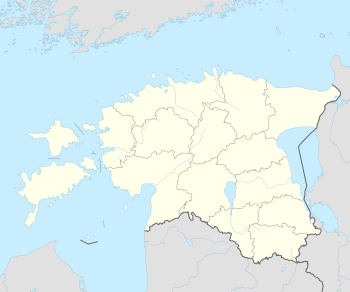Toila
| Toila | |
|---|---|
| Small borough | |
|
View from the location of the former Oru Palace. | |
 Toila Location in Estonia | |
| Coordinates: 59°25′14″N 27°30′35″E / 59.42056°N 27.50972°ECoordinates: 59°25′14″N 27°30′35″E / 59.42056°N 27.50972°E | |
| Country | Estonia |
| County | Ida-Viru County |
| Municipality | Toila Parish |
| Population (2011 Census[1]) | |
| • Total | 780 |
Toila is a small borough (alevik) in Ida-Viru County, in northeastern Estonia. It's located about 10 km (6 mi) northeast from the town of Jõhvi, on the coast of the Narva Bay (part of Gulf of Finland). Toila is known as an important sea resort in Estonia, with a spa hotel, beach and a beautiful park (Oru Park). Toila is the administrative centre of Toila Parish. As of 2011 Census, the settlement's population was 780, of which the Estonians were 628 (80.5%).[1]
History
The existence of an ancient settlement in Toila is suggested by a sacred grove (hiis) on a high coastal cliff, offering springs of Pühajõgi River, and an offering stone in the current park. The oldest found tarand grave in Virumaa is located beside the current Toila cemetery. The burials there took place in two periods: 2nd–4th and 7th–8th centuries AD.[2][3]
The first written record about the Toila area Danish Census Book, mentions the neighbouring Pühajõe as a village with a size of 6 hides.[2] In 1426 neighbouring Kärilõpe village (now Altküla) was mentioned. In 1547 the site of nowadays Toila was mentioned as Männiku, where a knight manor was situated.[4]
During the Great Northern War, Russian cavlary general Boris Sheremetev built reduits around Pühajõgi, to hinder Charles XII in approaching the Battle of Narva.[2]
Toila as a summer resort was discovered in the middle of the 19th century. The first tens of summer cottages were erected in the 1870s. On the second half of the century, a harbour was built to the estuary of the Pühajõgi River. Among local folks it became known as the "King's Jetty" (Kuninga muul). In 1914, the number of vacationists exceeded a thousand, while the number of residents was around 500. After the World War I, the number of vacationists from Russia drastically decreased and Toila was used by only several hundred of vacationists, mostly Estonian intellectuals.[2][3]
In the end of the 19th century Russian merchant Grigory Yeliseyev bought land for his new summer residence in Toila. A palace in the Italian renaissance style designed by Gavriil Baranovsky and a large park by Georg Kuphaldt were established. From 1934 to 1940 the palace, known as Oru Palace, was used as the summer residence of the first Estonian president Konstantin Päts. The palace was destroyed in the Second World War.
Notable people
- Konstantin Päts (1874–1956), President of Estonia, summered in the Oru Castle from 1934 to 1940.
- Igor Severyanin (1887–1941), Russian poet, summered in Toila since 1910 and lived from 1918 until 1935.[5]
- Notable vacationists in Toila include:
- Writers and poets: Valmar Adams, Artur Adson, Betti Alver, August Gailit, Jüri Parijõgi, Aleksis Rannit, Johannes Semper, Igor Severyanin, Friedebert Tuglas, Marie Under, Henrik Visnapuu;
- Actors: Leo Kalmet, Felix Moor, Netty Pinna, Paul Pinna, Salme Reek;
- Musicians: Artur Kapp, Jenny Siimon, Eduard Tubin, Aleksander Thomson;
- Artists: Johann Köler, Ado Vabbe;
- Cultural and political figures: Carl Robert Jakobson, Konstantin Päts, Jaan Poska.
Gallery
 Toila Spa Hotel
Toila Spa Hotel Toila Beach
Toila Beach Mouth of Pühajõgi River in Toila
Mouth of Pühajõgi River in Toila The Oru Palace before the World War II
The Oru Palace before the World War II The promenade of the palace
The promenade of the palace- Pühajõgi River in the park


 Toila cemetery
Toila cemetery Cemetery of German soldiers
Cemetery of German soldiers The settlement
The settlement
References
- 1 2 "Number and share of Estonians by place of residence (settlement)". Statistics Estonia. 31 December 2011. Retrieved 31 May 2013.
- 1 2 3 4 "Toila kuurorttoote perspektiivse väljaarendamise kava" (in Estonian). Toila vallavalitsus. 2008. p. 30.
- 1 2 "Toila alevik" (in Estonian). eestigiid.ee. Retrieved 22 June 2013.
- ↑ "Toila kodulugu" (in Estonian). Toila Gymnasium. Retrieved 22 June 2013.
- ↑ Lauwers, Lenie (1993). Igor'-Severjanin. Peeters Publishers. ISBN 90-6831-491-2.
External links
- Toila Parish (Estonian)
- Toila Spa Hotel
| Wikimedia Commons has media related to Toila. |
| Wikivoyage has a travel guide for Toila. |

